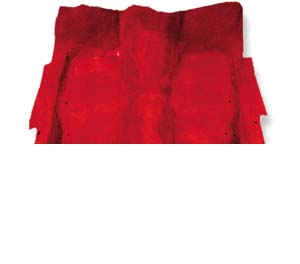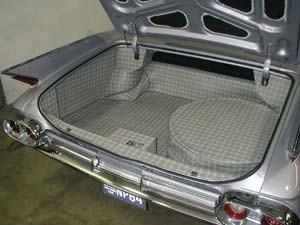|
Contour-Sewn Carpets
For models from the 1920’s to the early1960’s, floor carpeting is
cut and sewn to contour to the shape of the floor. The pleated seams allow the
carpet to flow over the transmission tunnel without wrinkling, similar to the
way your shirt is seamed to take the rounded shape of your shoulder.
Generally, the carpet is made in two pieces, one across the front and one across
the rear. Carpet for most other trim areas is also available including, where
applicable, the rear footrest, side rails, firewall, door bottoms and kick panels.
New jute padding and sewn on heel plates are included with all carpet sets as
well as a dimmer switch grommet where needed.

Molded Carpets
For models from the late 1950’s to current, the floor carpeting is molded
to the shape of the floor pan. That is, sheets of carpet are put into an oven
and heated. They are then placed in a mold and pressed to the shape of the
floor. The carpet is removed from the mold, it cools, is trimmed and retains
the contour of the floor pan, with no need for any sewn seams.

Up to the mid 1970’s, the carpet was molded in two pieces, one across
the front and one across the back. From the mid 1970’s to current,
most carpets are molded in one piece. This is why when a section gets damaged
it
is necessary to change the complete carpet.
All molded carpets also include new, jute padding and sewn on heel plates.
Trunk Carpets/Liners & Cargo
Deck Areas
Don’t forget to also refinish the trunk or cargo deck area of your car.
For classics, original style rubber, vinyl, burtex & cardboard with printed
patterns such as herringbone, houndstooth, and various plaids
are available. Trunk mats, as well as tire covers and side walls, may also
be made from plush carpeting or trunk lining material.
Station wagon and hatchback cargo area carpet is also available pre-contoured
for many models. For other models, additional yardage may be ordered to finish
these sections.


|
|
|
|

Choose Your Material
Over 20 grades of material are available as well as over 300 colors.
a. Original
Antiques and classics through the1940’s used various types of wool carpeting.
In the 1950’s, various types of loop carpets were introduced. Beginning
in the mid 1970’s and running through today, nylon pile in a range of
densities has become the industry norm.
b. Economical Substitute
If you are fixing up an older model which doesn’t necessarily warrant
the higher expense of an original wool carpet, you may choose a more economical
nylon pile. Likewise, a nylon loop may be substituted for some of the original
higher end loop carpets.
c. Upgrade
If you are building a street rod or some other show car, or if you simply prefer
something better, you may upgrade to a higher quality carpet material to
maximize the look and feel of the interior.
d. Carpet Material Description
See the yard goods section for more detailed information about the specific
materials.
Return to home page
|




